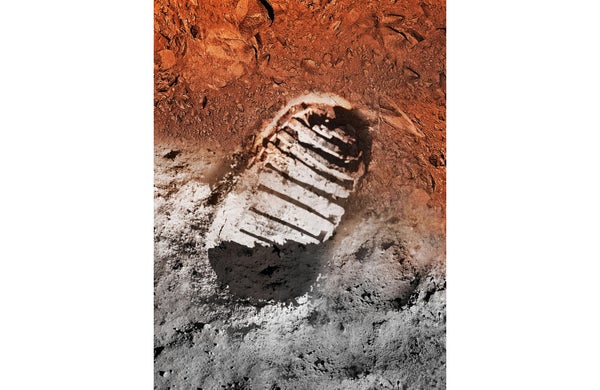The Martians invaded Houston one morning in October of last year—although in truth some of them already lived there. As home to NASA’s astronaut corps at Johnson Space Center and the NASA-funded Lunar and Planetary Institute, Houston probably has the highest per capita density of aspiring Martians on Earth. The rest of the Martians were a motley crew of scientists, engineers, physicians and bureaucrats who came from around the country and even the globe to fill the Institute’s auditorium for a historic workshop. They all were there to discuss their common dream: sending human beings to the freeze-dried desert planet right next door that, outside of our own, remains the most hospitable world in the known universe.
Some 20 years from now, if current timelines are to be trusted, that dream will at last become a reality. Housed in a crew capsule called Orion, NASA astronauts will soar into orbit on an advanced version of the Space Launch System, a rocket bigger than the Saturn 5 that took their predecessors to the moon. In orbit they will dock with other spacecraft, including a deep-space habitat, then fly away, leaving Earth far behind. Months later they will arrive at Mars, descending to the planet in a habitat lander. They will spend up to several hundreds of days on the surface constructing a base, exploring their surroundings and manufacturing rocket fuel. At the end of their stay, that rocket fuel will power a Mars Ascent Vehicle, which will launch those first pioneers back to the deep-space habitat and then to Earth. The base will remain for use and expansion by future crews as part of a broader “Evolvable Mars Campaign.”
All told, the first round-trip journey will probably take about three years and will be part of a larger program costing several hundreds of billions of dollars. NASA is already working feverishly on this grand endeavor; 20 years, it turns out, isn’t a lot of time to mount an expedition to another planet. If successful, this decades-long sprint would become a landmark moment in space exploration and in human history, as our species for the first time establishes an enduring presence on another world, and perhaps finds conclusive evidence that we are not alone in the universe.
On supporting science journalism
If you're enjoying this article, consider supporting our award-winning journalism by subscribing. By purchasing a subscription you are helping to ensure the future of impactful stories about the discoveries and ideas shaping our world today.
And yet despite all of these elaborate plans and their epochal implications, the effort still seems somehow whimsical, because there is still one key missing detail: An actual place—rather than an entire planet—where humanity’s next and greatest adventure may truly begin. That is, a landing site.
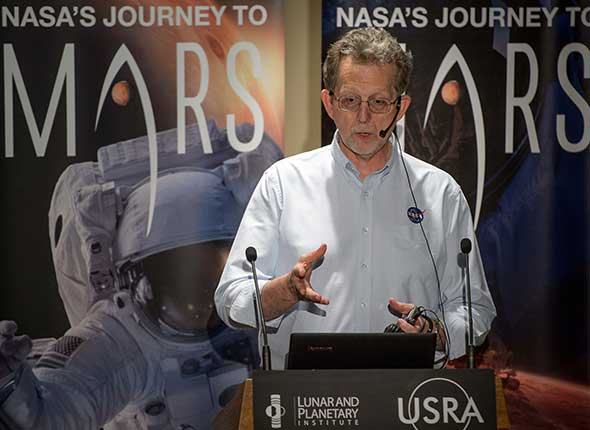
Jim Green, director of NASA’s planetary science division, speaks during the First Landing Site/Exploration Zone Workshop for Human Missions to the Surface of Mars. Within a decade, Green says, a U.S. President will select a landing site from a NASA shortlist. “That will be the moment that we know we’re going to Mars.”
Credit: NASA/Bill Ingalls
Mapping out a Martian future
With just a bit more than half of Earth’s radius and a tenth its mass, Mars possesses about a third of our world’s surface area—planetary real estate roughly equivalent to all of Earth’s continents. Hardly any of it has been closely explored: Walk around the perimeter of Manhattan and run a 5K, and you’ve traversed more of Earth’s surface than all our rovers combined have of Mars. That hadn’t stopped the Martians from assembling long lists of places they want to go, however.
In the sunlit rotunda outside the Lunar and Planetary Institute’s auditorium they had placed permanent markers and two glossy, oversize maps of Mars on foldout tables. Each participant autographed the maps, as if a delegate signing an interplanetary Declaration of Independence, usually marking the site where he or she hoped humans would go first. Before long both maps accumulated thick clusters of signatures marking 45 potential “Exploration Zones,” or EZs. Each EZ was a circle 200 kilometers wide, equaling an area nearly 20 times larger than the sprawling city of Houston. This diameter represents just how far NASA’s planners think astronauts might roam over the course of several long-duration missions. Each EZ contained a central landing site, surrounded by regions of interest that held promise for scientific investigations or harvesting resources.
Produced in anticipation of the workshop, this NASA animation depicts one possible concept out of many for a Mars base built up over multiple expeditions to an “Exploration Zone,” or EZ.
The workshop’s organizers gave proponents of each EZ a 15-minute speaking slot to make their case, compressing discussion of the entire planet into quarter-hour chunks spread across three days. Almost the entire planet, anyway. Among the signatures scattered on the map, there were voids conspicuously light on scrawls—places where no human would tread anytime soon, if ever. Over the course of the workshop, the voids came into sharper focus: No human missions would come closer to the poles than 50 degrees latitude, and no landing sites would be higher or lower than two kilometers from what on parched Mars would count as “sea level.” At higher elevations, the atmosphere would be too thin for parachutes to slow down descending spacecraft, and at lower elevations the thicker air could hold enough dust to scuttle a smooth rocket landing. EZs too far north or south would pose problems for rockets, too. Without the extra kick from the planet’s equatorial spin, a crew launching back to orbit from near the poles would have to burn more fuel, dangerously reducing their margin for error. The poles harbor the bulk of the planet’s proved reservoirs of water ice, but to access them astronauts would have to survive winters of constant darkness and temperatures below –150 degrees Celsius.
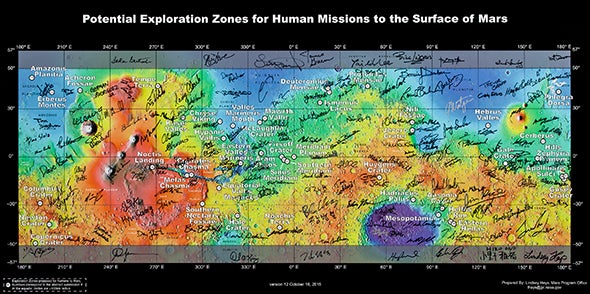
This topographic map of Mars shows all the 200-kilometer-wide EZs considered at the workshop, as well as signatures from the workshop’s participants. The grayed-out high latitudes at the map’s top and bottom are considered too dangerous for near-future human landings, as are areas of extreme elevation. The lowest elevations are in violet and blue, while the highest are in white and brown.
Credit: NASA/JPL-Caltech/Lindsay Hays/MOLA Science Team
A few of the workshop’s participants chafed at these restrictions—but none of the attending astronauts did. They seemed to view Mars less as a lifeless world to be explored and more as a slumbering beast they might someday be ordered to poke with a stick. The trick was to poke the beast without dying, and one of the surest ways to die was to poke in the wrong place. The most gung ho calls for treks to the polar caps or forays to mountain peaks and deep caverns inevitably came from a handful of scientists and engineers who would never have to do those dangerous deeds themselves. In private, one participant mocked them as “the ‘All You Gotta Do’ guys,” after the mantra they invariably recited before proposing simplistic fixes for deadly problems crews might encounter on Mars. Although it had been organized to bring the Martians to some rough consensus, the gathering perhaps succeeded most in exposing their differences.
Besides the Greek chorus of the “All You Gotta Do” tribe, there were also Groundlings, who preferred to select sites based on the intimate-but-sparse data from rovers, and Overseers, who chose their spots using the comprehensive-but-distant data from orbiters. There were Old Faithfuls, who wanted to revisit well-scouted locales, and there were Trailblazers, who wished to go anywhere but the familiar favorites. There were Brights, who wanted to build habitats on the sunlit surface, and there were Burrowers, who preferred to put them underground.
The workshop’s biggest split, however, proved to be the rift that developed between two factions arguing over how to treat Mars when and if they got there. Conservationists were willing to handicap human exploration for the sake of keeping the planet a pristine nature preserve; Colonials wished to prospect and settle Mars for both scientific and economic gains. Their clash marked an early battle in what could someday become a war for the planet’s future.
The most Earth-like place on Mars
Mars hasn’t always been a frozen desert. Viewed from orbit, much of the surface shows evidence that the planet was once quite Earth-like, a world of flowing water covered with rivers, lakes and seas. Mars was not stillborn; it somehow succumbed to infant mortality. Researchers now believe that by a few billion years ago, its atmosphere had grown so tenuous and frigid that almost all its water drifted into space or froze belowground or at the poles. At the time Earth was just growing green with the first stirrings of photosynthesis, but any biosphere on Mars was already an eon in the red. Any surface life would have been forced to retreat to the planet’s marginalia, doomed to subsistence in the planet’s subsurface. Learning whether and why one planet died while the other lived is the central concern of most Mars-focused science, and the path to finding any Earth-like refuges still remaining on that barren world.
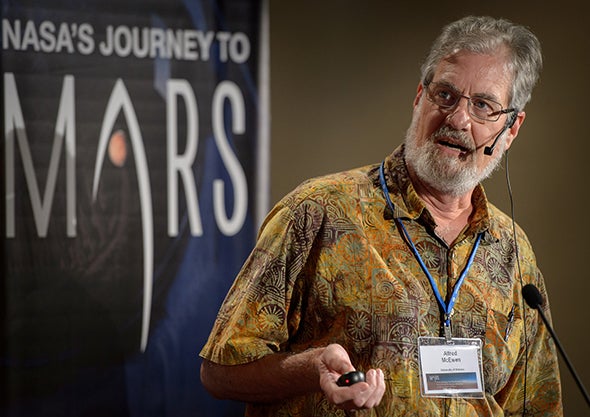
The University of Arizona geologist and HiRISE science team director Alfred McEwen speaks at the workshop. Throughout his career, McEwen has produced some of the most iconic images of Mars, including what may be the most widely-circulated picture of the planet in history, a mosaic centered on the world’s sinuous Valles Marineris canyon complex.
Credit: NASA/Bill Ingalls
The person who might know Mars best is the University of Arizona geologist Alfred McEwen. McEwen has a long, lined face behind a gray short box beard, a penchant for Hawaiian shirts and a laconic wit as dry as Martian air. He leads the science team for a camera called HiRISE (High-Resolution Imaging Science Experiment) on NASA’s Mars Reconnaissance Orbiter, which arrived at the Red Planet in 2006. HiRISE can see features and elevation changes as small as 30 centimeters on the surface, about the size of a regulation soccer ball. Its images of Mars are so good, in fact, that they surpass those available of Earth from state-of-the-art commercial satellites. Whenever and wherever people set foot on Mars, HiRISE’s eagle eyes—and McEwen’s, too—will almost certainly have been there first. And so the Martians listen when HiRISE’s master, the chief of the Overseers, chooses to speak.
Perhaps not by chance, McEwen gave the workshop’s first EZ presentation, extolling the virtues of an EZ in the eastern reaches of a gorge called Melas Chasma. Melas Chasma lies in the depths of Valles Marineris, a giant gash formed and sculpted by erupting volcanoes, flowing water and roaring winds that scars one whole hemisphere of Mars near its equator.
McEwen’s preferred EZ sinks several kilometers deeper than the surrounding regions, brushing NASA’s limits for acceptable low altitude. Melas Chasma once held large volumes of water, he explained, and today it holds what on Mars amount to large volumes of air. It boasts some of the planet's highest atmospheric pressures, which, paired with abundant equatorial sunlight, means that in the long summer afternoons surface temperatures can easily surpass the freezing point of water. Melas Chasma is balmy by Martian standards. It is one of the most Earth-like places on Mars.
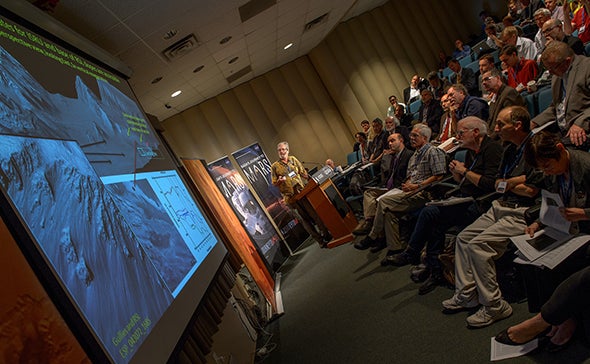
Using processed HiRISE images combined with other orbital data, McEwen makes the case for mining water-rich minerals from the slopes of an ancient lakebed within East Melas Chasma, his preferred EZ in the depths of Valles Marineris.
Credit: NASA/Bill Ingalls
Within the gorge’s walls, McEwen said, the full story of how Valles Marineris formed is waiting to be told, laid down in thousands of rock layers that stack up hundreds of meters along the canyon’s undulating topography, each layer a page in a lithic textbook. “It’s got fabulous geology,” McEwen told me. “Interior layer deposits, ancient bedrock, ancient lake deposits, sand dunes, landslides.” Send astronauts to chip away at the rocks of Melas Chasma and you could peer deep into the past of a former, warmer, wetter world, and perhaps even learn whether anything had ever lived there.
There is, however, a substantial stumbling block. The price to pay for the balmy temperatures of the Martian tropics is a desiccated crust where any exposed or shallow-buried water ice should have sublimated into the feeble air. Despite all its geologic riches, Melas Chasma lacks any obvious reservoirs to keep a crew alive and provide fuel for their return rocket home. McEwen’s solution is to squeeze water from stones. Billions of years ago, as its water drifted into space or froze as ice at the poles, some small fraction of Mars’s moisture must have instead become locked into minerals in the rocks. Images from HiRISE and other instruments suggest that Melas Chasma is rich in polyhydrated sulfates, minerals that by volume are up to half water. Dig a hole for an Olympic-size swimming pool in a bed of polyhydrated sulfates, and you could in theory fill it up halfway with water harvested from the debris. “Extracting the water is easy,” McEwen told the other Martians. “You just have to heat it above 150 degrees Celsius.” That is about the temperature of an oven baking bread. “Just for fun,” McEwen said, he had used satellite imagery to estimate the volume of the hydrated sulfate deposits in his EZ, and from that the amount of water it contained. He came up with a thousand cubic kilometers—enough to fill Lake Erie twice.
To find the needle, remove the haystack
The possibility of mining rocks for water is a godsend for the Old Faithful contingent. Most are also Groundlings, members of past and present rover and lander teams. They want to “go where you know,” to send humans to tread the trails scouted by their robots. Nearly all those robots have landed near Mars’s equator, and so equatorial sites dominate the Groundling and Old Faithful wish lists. But arguments for sending humans to these best-studied and presumably safest places hold water only if water can be found there.
Several presenters at the workshop wanted to send humans to Gale Crater, where the nuclear-powered Curiosity rover now gathers soil samples, sniffs the air and zaps rocks with lasers. The most bullish was Curiosity’s chief mapmaker, a stocky and hard-nosed geologist named Fred Calef from NASA’s Jet Propulsion Laboratory who argued for Gale during his presentation.
.jpg?w=590)
Composed of 57 separate images, this mosaic self-portrait from NASA’s Curiosity rover shows the robot perched at the edge of a basaltic sand dune within Gale Crater, a proposed EZ. Such dunes could potentially harbor enough adsorbed water to be used as a resource by human explorers.
Credit: NASA/JPL-Caltech/MSSS
The rover has already trundled through ancient riverbeds, alluvial fans and other evidence that Gale could have sustained life in the distant past. Calef thought Gale could sustain human life in the future, too, and had mapped out an ambitious network of camps, communications towers and traverses for a series of missions there. The rover’s latest explorations of Gale’s slate-colored dune fields showed they were composed of basaltic sand, which can sponge water vapor out of even very dry air. Calef estimated between 10,000 to a million metric tons of adsorbed water sat in the dunes, just waiting to be baked out.
During a Q&A session following the Gale presentations, it became clear not everyone was so enthused—particularly the Trailblazers. “I’m really disappointed in Mars,” said Paul Niles, a tall, wan NASA planetary scientist from Johnson Space Center who had worked on the agency’s Phoenix lander mission. “I don’t want to go back to Gale,” Niles went on. “We haven’t seen exciting stuff there—or at least the stuff I was really hoping to see.”
Niles and other Trailblazers had no shortage of EZ alternatives. For starters, there were the runner-up candidates for robotic missions, near-equatorial sites with signs of warm, wet pasts and names like Eberswalde Crater, Mawrth Vallis and Jezero Crater. Then there were the more far-out possibilities. Niles wanted to visit Aram Chaos, a giant crater filigreed with spidery cracks where the landscape had collapsed like a crushed eggshell, probably due to the sudden drainage of an ancient subsurface lake. JPL research scientist Laura Kerber lobbied for humans to build bases within the wind-sculpted ridges of Apollinaris Sulci, a petrified deposit of foamy, possibly ice-suffused volcanic ash about the size of the continental U.S. Via a video feed from Ukraine, researcher Valeriy Yakolev explained how the hills of Zephyria Planum probably contained enough water to support a 10,000-person colony for 500 years.
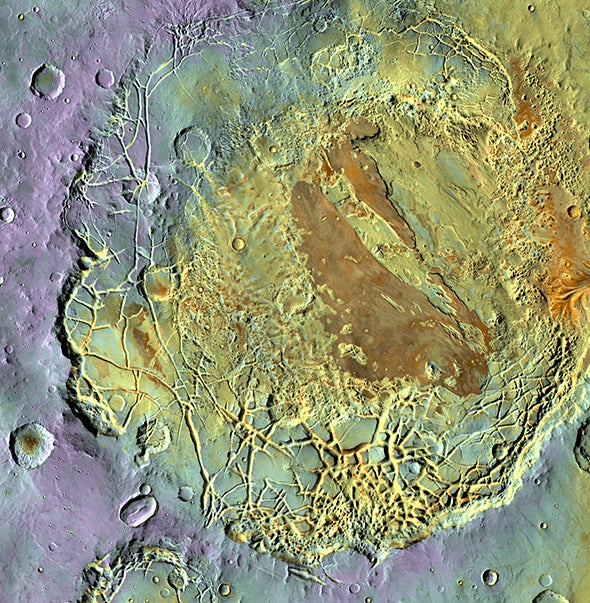
Produced by the drainage of an ancient subsurface lake, the fractured “chaos terrain” of proposed EZ Aram Chaos is revealed in this false-color mosaic from the Thermal Emission Imaging System on NASA’s Mars Odyssey orbiter. The mosaic covers nearly 300 square kilometers at a resolution of 100 meters. Rugged, rocky areas are shown in warmer colors, while smoother regions covered by sand or dust appear in cooler tones.
Credit: NASA/JPL-Caltech/Arizona State University
For Jacob Bleacher, an outspoken volcanologist from NASA Goddard Space Flight Center, the Old Faithful’s devotion to familiar sites was “a situation where we’ve found the needle, but we’ve completely removed the haystack.” Unless NASA invested in more expensive and time-consuming robotic precursor missions to unconventional, exotic locales, he said, it risked trapping itself into pumping a dry well, exhausting its Mars budget to revisit one middling place again and again just because it is expedient. “Forget the Mars money, these precursor missions could chew up all the money [in NASA] if they wanted to!” scoffed Mike Seibert, a pugnacious engineer from JPL. Seibert was an Old Faithful, and one of the drivers for the Opportunity rover. He hoped to save money by sending humans to the vicinity of Opportunity’s landing site, in a region called Meridiani Planum. “If we don’t want to forsake the rest of the solar system to put boots on the ground on Mars,” Seibert said, “we may need to start with that needle we have instead of what might be somewhere else in the haystack.”
One possible way forward would be for NASA to send a new orbiter to Mars early in the next decade, as early as 2022; one equipped with even better cameras to study the surface—and ground-penetrating radar to peer deep beneath it. That orbiter could bridge the gaps between the Overseers and the Groundlings, the Old Faithfuls and the Trailblazers, opening up more of the planet to serious consideration. Such a mission has yet to be codified into NASA's budget. The workshop was the Martians’ first, tentative step toward changing that.
Bombing glaciers for ice cubes
Unlike the Groundlings and Old Faithfuls, most of the Trailblazers didn’t want to land near the equator at all. Instead, they hoped to send humans to the cooler mid-latitudes where HiRISE and other instruments had revealed landscapes molded by subsurface ice. Roughly half of the workshop’s EZs were at high mid-latitudes, particularly in the ice-rich northern lowlands. “If you want a cold drink on Mars, if you want a drink of any kind, mid-latitude glacier ice and buried ground ice is the only proven reservoir that exists,” Joe Levy told the crowd during his presentation. He wanted to send astronauts to the rim of Hellas Basin, a giant impact crater in the southern mid-latitudes. Levy, a geologist at the University of Texas at Austin, had used satellite data to count and study features called lobate debris aprons—thought to be subsurface glaciers—seen throughout the mid-latitudes. At the end of the project, he had tallied more than 11,000, most of them likely containing billions of tons of water ice.
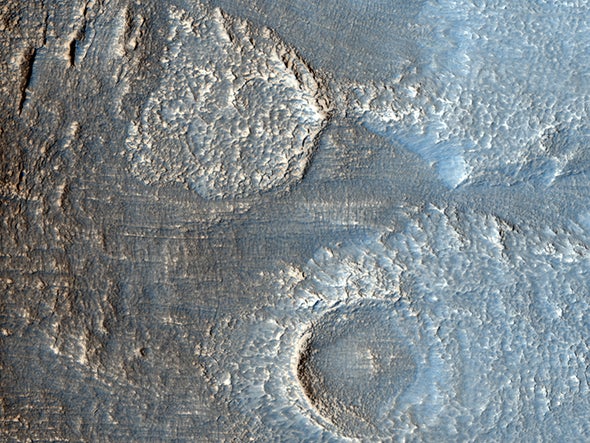
In this false-color HiRISE image, buried glaciers called “lobate debris aprons” flow down the slopes of mesas in Deuteronilus Mensae, a proposed EZ in the ice-rich mid-latitudes of Mars’s northern hemisphere. The image covers about one square kilometer of terrain, and captures details as small as 30 centimeters across.
Credit: NASA/JPL-Caltech/University of Arizona
“You can pick where you want your ice cubes from, and you just start chipping,” Levy said. Or, more provocatively, you could detonate a small bomb on a glacier to excavate “a practically unlimited pit mine for ice.” The weak Martian atmosphere could then perform most of the extraction and purification for free, sublimating the exposed ice into water vapor that could be condensed and collected using equipment scarcely more sophisticated than tarps. A few audience members shrugged their shoulders or shook their heads—Levy was veering into “All You Gotta Do” territory. Mining glaciers for drinking water and fuel, Levy went on, would also create ice caves to house crews and equipment, insulating them from the dangers of cosmic rays and dust storms. Levy was a Burrower, a Martian who thought the best prospects on the planet for extant life, human or otherwise, were in the subsurface. Someday, the Burrowers imagined, perhaps while surveying a cavern for a new human settlement, an astronaut might stumble across the last living remnants of Mars’s ancient biosphere, twisted by time and solitude into some shadowy, single-cellular form.
Naturally, there is tension here. Because Mars’s ice can be both an object of painstaking study and a bulk resource to be mined—even lived in—an astronaut in a habitat innocently showering or drinking a glass of water might inadvertently wash scientific breakthroughs down the drain or expose the crew to alien pathogens awakened from frozen hibernation. The final arbiter of where humans went on Mars could prove to have nothing to do with the troubles of rocketry, but rather with managing the threat of otherworldly cross-contamination—something that NASA and other space agencies call “planetary protection.” At the workshop, a prototypically trim and clean-cut NASA astronaut named Stan Love opted for a more colloquial term: “cooties.”
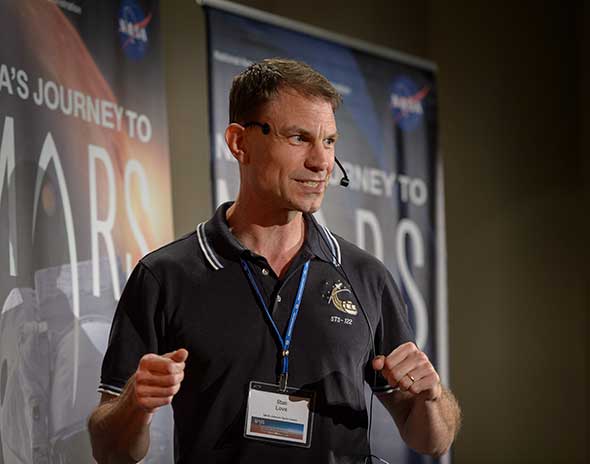
NASA astronaut Stan Love speaks at the workshop on the safety requirements that should guide the selection of an EZ. “[Astronauts] don’t care about the identity of the site,” Love says. “But we care deeply about whether the site is going to kill us, and whether having got there we can do any work.”
Credit: NASA/Bill Ingalls
“We’re gonna be venting bacteria and viruses all the time while we’re on Mars,” Love said. “If we can’t deal with it, we shouldn’t go…. Not only can you not prevent the people from leaking out into Mars, you can’t prevent Mars from coming back into the habitat with you.”
The Martians faced a conundrum, Love said. Human missions to the planet were sold to the public as searching for life, not just majestic rock formations. Life “is what makes people excited—and remember, the taxpayers fund us, so we have to work on what they think is interesting,” he said. “The mission will be less interesting if we go to a site that we know is biologically safe. You have a very tough choice.”
Red tape for the Red Planet
For the handful of scientists who have spent careers studying planetary protection, the choice isn’t tough at all—people simply shouldn’t go unless they can do so without spreading interplanetary cooties. They are the cautionary Conservationists of Mars.
Only one Conservationist, JPL’s Andy Spry, had shown up to represent this point of view. Spry’s graying hair and heavy-lidded eyes accentuated his world-weary, almost fatherly demeanor; he was a reluctant but consistent chaperone, faced with the thankless task of dissuading a vocal army of explorers eager to throw caution to the thin Martian winds. “Right now, we do not have the understanding to send a human mission to Mars safely without in some way contaminating the planet beyond what we understand,” he told me. Spry had similar fears for contaminating Earth itself and the explorers it sent. Whether back on Earth or in a habitat on Mars, anything from the Red Planet that potentially contained alien biological material should be handled with very great care. “Think ‘Ebola,’” he told the Martians.
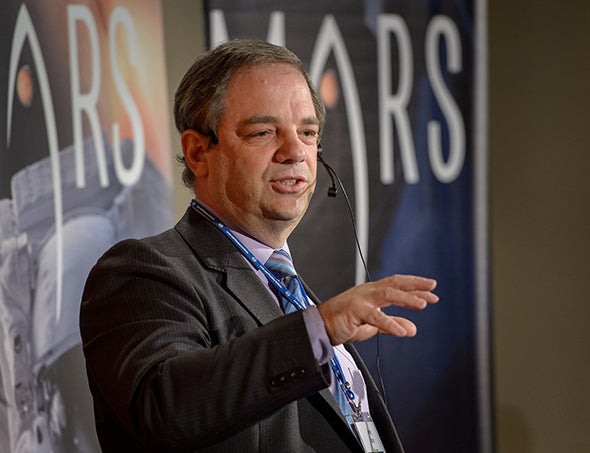
Andy Spry, a planetary protection specialist at JPL, speaks at the workshop about the difficulty of dealing with interplanetary biological contamination. “Currently, it is not possible to provide quantitative planetary protection guidelines,” Spry says. “Because we don’t have the necessary information about Mars, and our knowledge about life on Earth is incomplete.”
Credit: NASA/Bill Ingalls
In their quest to avoid biological catastrophe, the Conservationists have the law on their side—specifically, the United Nations Outer Space Treaty of 1967, which forbids the “harmful contamination” of celestial bodies by human exploration. An international organization called COSPAR (Committee on Space Research) sets planetary protection protocols that the U.S., Europe, Russia and other signatory spacefaring nations must follow to comply with the treaty. Those protocols require that even the robots sent to Mars undergo sterilization procedures that can add tens or even hundreds of millions of dollars to a mission’s cost. All this makes the Conservationists, the planetary protectors, decidedly unpopular among aspiring Martians. “Not everybody likes to think of humans as their own scientific worst enemy,” said NASA’s former planetary protection officer John Rummel, a professor at East Carolina University who did not attend the workshop. “But if you don’t take steps to limit human-associated contamination, the reasons to go and explore Mars evaporate, like the frost on Utopia Planitia on a summer afternoon.”
Utopia Planitia, a rock-strewn volcanic plain in the northern lowlands, was where one of NASA’s twin NASA Viking landers touched down in 1976 (the other landed on the other side of the planet, nearer the equator, at a site called Chryse Planitia). The Viking landers were the first to transmit pictures from the surface. Those images revealed sepia-tinted surroundings where so little happened day-to-day and year-to-year that the most major visible changes were the subtle comings and goings of micron-thin layers of water frost. The Vikings also were (and still are) the most costly and ambitious missions ever sent to Mars. Carrying automated chemistry labs designed to look for life, they were built to endure a rigorous prelaunch sterilization. After a 30-hour oven-bake at 125 degrees C, each Viking lander’s total microbial load was reduced to no more than 300,000 bacterial spores apiece—just over half the bacteria that would be found in a single dotlike colony growing in a petri dish.
Today, any life-seeking robot bound for Mars is still limited to no more than 300,000 total bacterial hitchhikers, just as the Vikings were. Planetary protection experts have calculated that those limits would give microbial stowaways only about a one-in-10,000 chance of successfully reproducing and spreading. Critics at the workshop pointed out that these “calculations” are little better than blind guesses. The restrictions set for the Vikings were based on how clean NASA could get a spacecraft in the 1970s, not how effective those levels of cleanliness would actually be on Mars. Depending on whom you ask and how soon they want to get to Mars, the Viking sterilization standards are either laughably inadequate safeguards or farcically expensive overkill.
Sitting in the audience, Dave Beatty, JPL’s chief scientist for Mars exploration, noted a minor problem that the standards posed for the workshop’s goals. According to some studies, Beatty said, an average human contains about a 100 trillion bacteria in or on their bodies—10 times the number of human cells. If the limits for landed hardware held for astronauts, too, Beatty continued, then “the landing of a human [on Mars] is not possible under current planetary protection policy.”
“Correct,” Spry replied. “The paradigm has to change if we are ever going to do human landings, because of what you just said. We’re essentially breaking the score limit just by sending one human, never mind four or six.”

Spry presents a chart of “Knowledge Gap Areas” that planetary protection experts insist be filled in before any meaningful limits can be set on microbial contamination levels for human missions.
Credit: Lee Billings
Changing the paradigm would require major breakthroughs in our abilities to monitor and manage microbial communities, whether on Earth or Mars. To illustrate the magnitude of the task, Spry displayed a chart of “knowledge gap areas” on a projection screen. The chart contained about 25 color-coded boxes, most of which were filled with so many words that the shrunk-to-fit text was too small for the Martians to read. In a way it didn’t matter, because Spry's dismaying message was already clear: Planetary protection could end up consuming as much time, energy and money as the actual act of sending the first humans to Mars.
No man’s lands
More than any other, one recent discovery has complicated the matter of choosing a landing site: Mars can no longer be considered the cold, dry desert of the Viking era. There appear to be a great many so-called “Special Regions” on the planet, areas defined by COSPAR as warm and wet enough for Earthly or presumably Martian microbes to thrive. In a 2015 joint review from the National Academy of Sciences and the European Science Foundation, the authors noted that the necessity of planetary protection could indefinitely “prevent humans from landing or entering” any and all of Mars’s Special Regions. And the closer we look at Mars, the more Special Regions we seem to find.
Alfred McEwen and his HiRISE team had discovered in 2011 that some parts of Mars are rich with features called “recurring slope lineae,” or RSLs—thin, dark lines that stretch down from high on the sun-illuminated sides of certain craters and hills. They ebb and flow with the seasons and with sunlight, darkening and growing by up to a meter per day when conditions are warmest, suggesting they are formed by rivulets of water at or just beneath the surface. In September 2015 NASA announced that data from another instrument conclusively linked the presence of RSLs with hydrated salts that can only form in water’s presence. More than 200 candidate RSL sites have been identified across the planet, with more than 50 confirmed. All are potential Special Regions, and thus off-limits to all rovers presently on the planet.
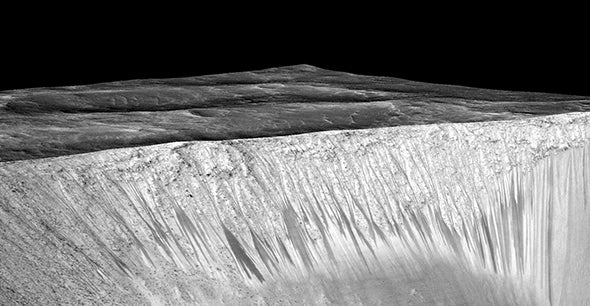
Long, dark streaks called “recurring slope lineae” stretch for hundreds of meters down the walls of Mars’s Garni Crater in this perspective view constructed from HiRISE data. Researchers believe the streaks, which appear to be widespread upon the Martian surface, are somehow produced by flows of liquid water.
Credit: NASA/JPL-Caltech/University of Arizona
At the workshop, McEwen speculated that the features might come from salts that produce brines by absorbing traces of water vapor from the atmosphere, meaning a typical RSL would contain barely any water at all. A second theory came from Steve Clifford, a square-jawed senior scientist at the Lunar and Planetary Institute. Clifford thought instead that the RSLs could emerge from the melting of salt-rich ice within soil. David Stillman, a lanky, baby-faced researcher at the Southwest Research Institute, presented the third and most breathtaking possibility. Based on controversial analyses of HiRISE images he performed with his colleague Robert Grimm, Stillman believes RSLs are products of an essentially global expanse of pressurized aquifers. HiRISE and other satellites, Stillman said, were seeing the runoff from natural springs that rise through fissures in rock when sunlight melts surmounting plugs of ice.
Stillman’s theory is far from bulletproof, but if validated, it would wholly reshape our view of Mars and the prospect of sending humans there. A crew would not need to bake rocks or melt ice to get water—instead they could simply lay pipes along and beneath an RSL’s flow front. The water would run downhill through the pipes to a habitat, where it could be purified and used. But globe-spanning aquifers would also constitute a potential habitat for extant, native life, effectively creating enormous Special Regions just beneath the surface that could prohibit human access to huge swaths of the planet forever. RSLs seem destined to be either the fulfillment of the Martians’ wildest dreams or the source of their worst nightmares.
A multiplanetary precedent
After three days of debate, the workshop concluded with no concrete, coordinated list of favored sites, only a promise to start producing one in the not-too-distant future. More data, the Martians said, were needed. More time. More money. More preparation.
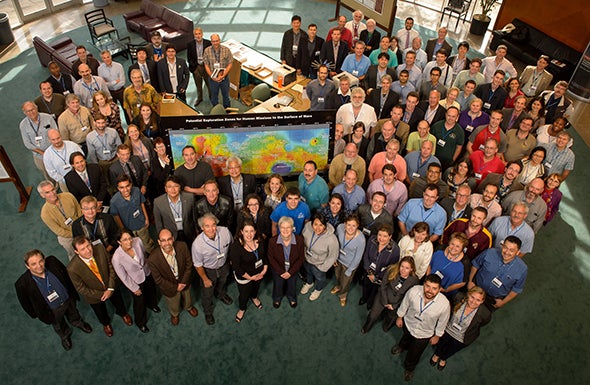
Are the first footprints on Mars close, or far away? When and where will humans land? Whenever and wherever humans visit the Red Planet, they are likely to live and work in a region first proposed by the workshop’s participants, gathered here in a group photo.
Credit: NASA/Bill Ingalls
Less than a month after the workshop, in remarks at an annual meeting of the American Geophysical Union (AGU), Elon Musk, the billionaire founder of the space transportation company SpaceX, made it clear he was tired of waiting. The planet’s surface is probably sterile, Musk said, and anything living deeper down should be safe from humans. Musk’s opinion reflects his aspirations: He is a Colonial through and through, with a goal of creating self-sustaining settlements on Mars and the game-changing rockets to do it. If NASA and other lumbering national space agencies were to be hobbled by the interplanetary Conservationists, his comments suggested, more agile private corporations like SpaceX need not be.
To Musk and many like him, reaching Mars quickly is about more than the scientific quest for knowledge; it is an insurance policy underwriting the future of humanity. Tragic though it may be, the Colonials say, the possibility of trampling alien microbes beneath humanity’s interplanetary footprints is infinitely preferable to allowing Earth’s lonely spark of sentience to fade. “Now is the first time in the history of Earth that the window is open, where it’s possible for us to extend life to another planet,” Musk told the AGU crowd. “That window may be open for a long time—and hopefully it is—but it also may be open for a short time. I think the wise move is to make life multiplanetary while we can.”
Later, I asked Clifford what he thought about such ideas, and whether he felt vexed by the tenets of planetary protection. Were Conservationists slowing Martian exploration too much? He replied that the pace could and perhaps should be even slower. Mars wasn’t going anywhere, whether or not our civilization’s era of spacefaring was winding down. The problem of going to Mars, Clifford said, is more a matter of ethics than of science or technology. Making a fresh start on a new world would be worthless if we only exported our old mistakes from Earth.
“In medicine, the prime edict is to do no harm,” he said. “That’s the attitude we should take in exploring Mars. Mars is the first place we’re going to really try to detect indigenous alien life, probably the first place beyond Earth we’re going to try to live, and it will set a precedent we will take with us out into the rest of the solar system, maybe even beyond. If life does exist somewhere on Mars, it has managed to survive there for billions of years. What is our curiosity compared to that? Does it give us the right to trespass without extreme caution? I’m not sure that possibly causing the demise of the first alien life we ever detect is the legacy we want to create.”
